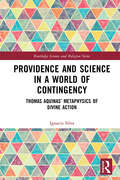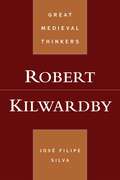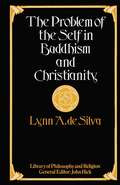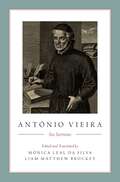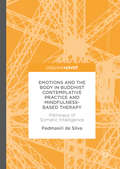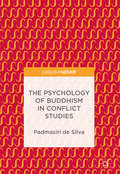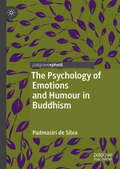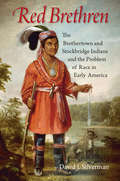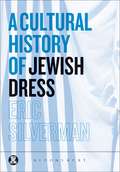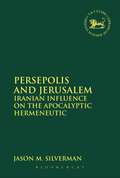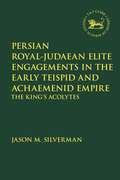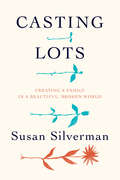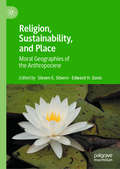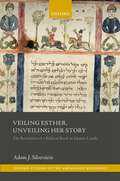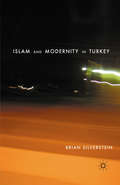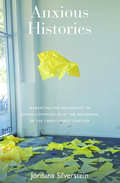- Table View
- List View
Providence and Science in a World of Contingency: Thomas Aquinas’ Metaphysics of Divine Action (Routledge Science and Religion Series)
by Ignacio SilvaProvidence and Science in a World of Contingency offers a novel assessment of the contemporary debate over divine providential action and the natural sciences, suggesting a re-consideration of Thomas Aquinas’ metaphysical doctrine of providence coupled with his account of natural contingency. By looking at the history of debates over providence and nature, the volume provides a set of criteria to evaluate providential divine action models, challenging the underlying, theologically contentious assumptions of current discussions on divine providential action. Such assumptions include that God needs causally open spaces in the created world in order to act in it providentially, and the unfitting conclusion that, if this is the case, then God is assumed to act as another cause among causes. In response to these shortcomings, the book presents a comprehensive account of Aquinas’ metaphysics of natural causation, contingency, and their relation to divine providence. It offers a fresh and bold metaphysical narrative, based on the thought of Thomas Aquinas, which appreciates the relation between divine providence and natural contingency.
Providence and Science in a World of Contingency: Thomas Aquinas’ Metaphysics of Divine Action (Routledge Science and Religion Series)
by Ignacio SilvaProvidence and Science in a World of Contingency offers a novel assessment of the contemporary debate over divine providential action and the natural sciences, suggesting a re-consideration of Thomas Aquinas’ metaphysical doctrine of providence coupled with his account of natural contingency. By looking at the history of debates over providence and nature, the volume provides a set of criteria to evaluate providential divine action models, challenging the underlying, theologically contentious assumptions of current discussions on divine providential action. Such assumptions include that God needs causally open spaces in the created world in order to act in it providentially, and the unfitting conclusion that, if this is the case, then God is assumed to act as another cause among causes. In response to these shortcomings, the book presents a comprehensive account of Aquinas’ metaphysics of natural causation, contingency, and their relation to divine providence. It offers a fresh and bold metaphysical narrative, based on the thought of Thomas Aquinas, which appreciates the relation between divine providence and natural contingency.
Robert Kilwardby (Great Medieval Thinkers)
by José Filipe SilvaArchbishop of Canterbury from 1272 until his death in 1279, the Dominican friar Robert Kildwardby has long been known primarily for his participation in the Oxford Prohibitions of 1277, but his contributions spread far wider. A central figure in the Late Middle Ages, Kilwardby was one of the earliest commentators of the work of Aristotle, as well as an unwavering proponent of Augustinian thought and a believer of the plurality of forms. Although he was a prominent thinker of the time, key areas of his philosophical thought remain unexamined in contemporary scholarship. José Filipe Silva here offers the first book-length analysis of Kilwardby's full body of work, which is essential in understanding both the reception of Aristotle in the Latin West and the developments of later medieval philosophy. Beginning with his early philosophical commitments, Silva tracks Kilwardby's life and academic thought, including his theories on knowledge, moral happiness, and the nature of the soul, along with his attempts to reconcile Augustinian and Aristotelian thought. Ultimately, Robert Kilwardby offers a comprehensive overview of an unsung scholar, solidifying his philosophical legacy as one of the most influential authors of the Late Middle Ages.
ROBERT KILWARDBY GMT C (Great Medieval Thinkers)
by José Filipe SilvaArchbishop of Canterbury from 1272 until his death in 1279, the Dominican friar Robert Kildwardby has long been known primarily for his participation in the Oxford Prohibitions of 1277, but his contributions spread far wider. A central figure in the Late Middle Ages, Kilwardby was one of the earliest commentators of the work of Aristotle, as well as an unwavering proponent of Augustinian thought and a believer of the plurality of forms. Although he was a prominent thinker of the time, key areas of his philosophical thought remain unexamined in contemporary scholarship. José Filipe Silva here offers the first book-length analysis of Kilwardby's full body of work, which is essential in understanding both the reception of Aristotle in the Latin West and the developments of later medieval philosophy. Beginning with his early philosophical commitments, Silva tracks Kilwardby's life and academic thought, including his theories on knowledge, moral happiness, and the nature of the soul, along with his attempts to reconcile Augustinian and Aristotelian thought. Ultimately, Robert Kilwardby offers a comprehensive overview of an unsung scholar, solidifying his philosophical legacy as one of the most influential authors of the Late Middle Ages.
The Problem of the Self in Buddhism and Christianity (Library of Philosophy and Religion)
by Lynn A. SilvaAntónio Vieira: Six Sermons
by Mónica Leal Silva Liam BrockeyThis volume is the first English translation and annotation of the sermons of António Vieira, a major cultural figure in the Portuguese-speaking world. Born in Lisbon in 1608, Vieira was a Jesuit who lived and worked in both Europe and Brazil in the service of the church and the Portuguese crown. His sermons are among the most renowned pieces of baroque oratory in the Portuguese language. These carefully selected sermons offer insight into Vieira's visionary thought on social and spiritual matters. In the Sermon for the Success of Portuguese Arms against the Dutch, Vieira inveighs against God for His apparent abandonment of the Portuguese and begs for divine intervention. His Sermon of St. Anthony is an allegory that addresses the inequities that he witnessed in Brazil. The Sexagesima Sermon parodies literary clichés from his time while prescribing a more effective, if harsher, style of preaching. The Sermon of the Good Thief is a rebuke to the imperial officials who used their positions for personal enrichment, and a warning to kings against complicity with corruption. Vieira's Sermon XXVII addresses African slaves and their Brazilian masters, attempting to comfort the first group in their trials and to admonish the second for their brutality. Finally, the Sermon called Arm tells the story of the relic of Francis Xavier's arm sent from India to Italy in 1614, and pays tribute to the obedience of Vieira's Jesuit predecessor.
António Vieira: Six Sermons
by Mónica Leal Silva Liam BrockeyThis volume is the first English translation and annotation of the sermons of António Vieira, a major cultural figure in the Portuguese-speaking world. Born in Lisbon in 1608, Vieira was a Jesuit who lived and worked in both Europe and Brazil in the service of the church and the Portuguese crown. His sermons are among the most renowned pieces of baroque oratory in the Portuguese language. These carefully selected sermons offer insight into Vieira's visionary thought on social and spiritual matters. In the Sermon for the Success of Portuguese Arms against the Dutch, Vieira inveighs against God for His apparent abandonment of the Portuguese and begs for divine intervention. His Sermon of St. Anthony is an allegory that addresses the inequities that he witnessed in Brazil. The Sexagesima Sermon parodies literary clichés from his time while prescribing a more effective, if harsher, style of preaching. The Sermon of the Good Thief is a rebuke to the imperial officials who used their positions for personal enrichment, and a warning to kings against complicity with corruption. Vieira's Sermon XXVII addresses African slaves and their Brazilian masters, attempting to comfort the first group in their trials and to admonish the second for their brutality. Finally, the Sermon called Arm tells the story of the relic of Francis Xavier's arm sent from India to Italy in 1614, and pays tribute to the obedience of Vieira's Jesuit predecessor.
Emotions and The Body in Buddhist Contemplative Practice and Mindfulness-Based Therapy: Pathways of Somatic Intelligence
by Padmasiri De SilvaThis book represents an outstanding contribution to the field of somatic psychology. It focuses on the relationship between body and emotions, and on the linkages between mindfulness-based emotion studies and neuroscience. The author discusses the awakening of somatic intelligence as a journey through pain and trauma management, the moral dimensions of somatic passions, and the art and practice of embodied mindfulness. Issues such as the emotions and the body in relation to Buddhist contemplative practice, against the background of the most recent findings of current neuroscience, are expanded in the book. A broad review of the Darwinian-Jamesian heritage on emotion studies is a unique contribution to the tradition of the somatogenic strands of emotions, and provides a contrasting focus to the ideogenic emotions in Sigmund Freud. This work provides an invaluable resource for students of psychology and philosophy, psychotherapists and meditation teachers, students, and for anyone with an interest in the field of somatic psychology.
Emotions and The Body in Buddhist Contemplative Practice and Mindfulness-Based Therapy: Pathways of Somatic Intelligence
by Padmasiri De SilvaThis book represents an outstanding contribution to the field of somatic psychology. It focuses on the relationship between body and emotions, and on the linkages between mindfulness-based emotion studies and neuroscience. The author discusses the awakening of somatic intelligence as a journey through pain and trauma management, the moral dimensions of somatic passions, and the art and practice of embodied mindfulness. Issues such as the emotions and the body in relation to Buddhist contemplative practice, against the background of the most recent findings of current neuroscience, are expanded in the book. A broad review of the Darwinian-Jamesian heritage on emotion studies is a unique contribution to the tradition of the somatogenic strands of emotions, and provides a contrasting focus to the ideogenic emotions in Sigmund Freud. This work provides an invaluable resource for students of psychology and philosophy, psychotherapists and meditation teachers, students, and for anyone with an interest in the field of somatic psychology.
The Psychology of Buddhism in Conflict Studies
by Padmasiri De SilvaThis book provides an interdisciplinary discussion of conflict studies, drawing on perspectives from psychology and Buddhist studies. The author combines current research in psychology, conflict and management studies, as well as moral narratives drawn from religious and cultural contexts, to offer useful guidance on dealing with conflict and dichotomies. Drawing on a vast corpus of Buddhist literature, this book examines complex teachings, ideas and doctrines to bring insight to how individuals and societies might lead peaceful and balanced lifestyles. In this ground-breaking study Padmasiri De Silva insists that the social studies need to develop dialectical methods and understanding in addition to the objective and analytical collection of facts. Chapters cover an array of subjects including economics, ecology, human wellbeing, prison reform, dialectical behaviour therapy, multiculturalism, and peace studies.
The Psychology of Buddhism in Conflict Studies
by Padmasiri De SilvaThis book provides an interdisciplinary discussion of conflict studies, drawing on perspectives from psychology and Buddhist studies. The author combines current research in psychology, conflict and management studies, as well as moral narratives drawn from religious and cultural contexts, to offer useful guidance on dealing with conflict and dichotomies. Drawing on a vast corpus of Buddhist literature, this book examines complex teachings, ideas and doctrines to bring insight to how individuals and societies might lead peaceful and balanced lifestyles. In this ground-breaking study Padmasiri De Silva insists that the social studies need to develop dialectical methods and understanding in addition to the objective and analytical collection of facts. Chapters cover an array of subjects including economics, ecology, human wellbeing, prison reform, dialectical behaviour therapy, multiculturalism, and peace studies.
The Psychology of Emotions and Humour in Buddhism
by Padmasiri De SilvaThis book examines the psychological dimensions of emotions and humour in Buddhism. While there is a wealth of material concerning human emotions related to humour and the mindful management of negative emotions, very little has been written on the theory of Buddhist humour. Uniting both Buddhist and Western philosophy, the author draws upon the theory of ‘incongruity humour’, espoused by figures such as Kierkegaard, Kant and Hegel and absorbed into the interpretation of humour by the Buddhist monk and former Western philosopher, Ñāṇavīra Thero. The author makes extensive use of rich primary sources such as the parables used by Ajahn Brahm while interweaving Western theories and philosophies to illuminate this original study of humour and emotion. This pioneering work will be of interest and value to students and scholars of humour, Buddhist traditions and existentialism more widely.
The Psychology of Emotions and Humour in Buddhism
by Padmasiri De SilvaThis book examines the psychological dimensions of emotions and humour in Buddhism. While there is a wealth of material concerning human emotions related to humour and the mindful management of negative emotions, very little has been written on the theory of Buddhist humour. Uniting both Buddhist and Western philosophy, the author draws upon the theory of ‘incongruity humour’, espoused by figures such as Kierkegaard, Kant and Hegel and absorbed into the interpretation of humour by the Buddhist monk and former Western philosopher, Ñāṇavīra Thero. The author makes extensive use of rich primary sources such as the parables used by Ajahn Brahm while interweaving Western theories and philosophies to illuminate this original study of humour and emotion. This pioneering work will be of interest and value to students and scholars of humour, Buddhist traditions and existentialism more widely.
Red Brethren: The Brothertown and Stockbridge Indians and the Problem of Race in Early America
by David J. SilvermanNew England Indians created the multitribal Brothertown and Stockbridge communities during the eighteenth century with the intent of using Christianity and civilized reforms to cope with white expansion. In Red Brethren, David J. Silverman considers the stories of these communities and argues that Indians in early America were racial thinkers in their own right and that indigenous people rallied together as Indians not only in the context of violent resistance but also in campaigns to adjust peacefully to white dominion. All too often, the Indians discovered that their many concessions to white demands earned them no relief. In the era of the American Revolution, the pressure of white settlements forced the Brothertowns and Stockbridges from New England to Oneida country in upstate New York. During the early nineteenth century, whites forced these Indians from Oneida country, too, until they finally wound up in Wisconsin. Tired of moving, in the 1830s and 1840s, the Brothertowns and Stockbridges became some of the first Indians to accept U.S. citizenship, which they called "becoming white," in the hope that this status would enable them to remain as Indians in Wisconsin. Even then, whites would not leave them alone.Red Brethren traces the evolution of Indian ideas about race under this relentless pressure. In the early seventeenth century, indigenous people did not conceive of themselves as Indian. They sharpened their sense of Indian identity as they realized that Christianity would not bridge their many differences with whites, and as they fought to keep blacks out of their communities. The stories of Brothertown and Stockbridge shed light on the dynamism of Indians' own racial history and the place of Indians in the racial history of early America.
A Cultural History of Jewish Dress (Dress, Body, Culture)
by Eric SilvermanA Cultural History of Jewish Dress is the first comprehensive account of how Jews have been distinguished by their appearance from Ancient Israel to the present. For centuries Jews have dressed in distinctive ways to communicate their devotion to God, their religious identity, and the proper earthly roles of men and women. This lively work explores the rich history of Jewish dress, examining how Jews and non-Jews alike debated and legislated Jewish attire in different places, as well as outlining the big debates on dress within the Jewish community today.Focusing on tensions over gender, ethnic identity and assimilation, each chapter discusses the meaning and symbolism of a specific era or type of Jewish dress. What were biblical and rabbinic fashions? Why was clothing so important to immigrant Jews in America? Why do Hassidic Jews wear black? When did yarmulkes become bar mitzvah souvenirs? The book also offers the first analysis of how young Jewish adults today announce on caps, shirts, and even undergarments their striving to transform Jewishness from a religious and historical heritage into an ethnic identity that is hip, racy, and irreverent. Fascinating and accessibly written, A Cultural History of Jewish Dress will appeal to anybody interested in the central role of clothing in defining Jewish identity.
A Cultural History of Jewish Dress (Dress, Body, Culture)
by Eric SilvermanA Cultural History of Jewish Dress is the first comprehensive account of how Jews have been distinguished by their appearance from Ancient Israel to the present. For centuries Jews have dressed in distinctive ways to communicate their devotion to God, their religious identity, and the proper earthly roles of men and women. This lively work explores the rich history of Jewish dress, examining how Jews and non-Jews alike debated and legislated Jewish attire in different places, as well as outlining the big debates on dress within the Jewish community today.Focusing on tensions over gender, ethnic identity and assimilation, each chapter discusses the meaning and symbolism of a specific era or type of Jewish dress. What were biblical and rabbinic fashions? Why was clothing so important to immigrant Jews in America? Why do Hassidic Jews wear black? When did yarmulkes become bar mitzvah souvenirs? The book also offers the first analysis of how young Jewish adults today announce on caps, shirts, and even undergarments their striving to transform Jewishness from a religious and historical heritage into an ethnic identity that is hip, racy, and irreverent. Fascinating and accessibly written, A Cultural History of Jewish Dress will appeal to anybody interested in the central role of clothing in defining Jewish identity.
Persepolis and Jerusalem: Iranian Influence on the Apocalyptic Hermeneutic (The\library Of Hebrew Bible/old Testament Studies)
by Jason M. SilvermanPersepolis and Jerusalem reconsiders Iranian influence upon Jewish apocalyptic, and offers grounds upon which such study may proceed. After describing the history of scholarship on the question of Iranian influence and on Jewish apocalyptic, Jason M. Silverman reformulates the methodology for understanding apocalyptic and influence. Two chapters set the discussion firmly in the Achaemenid Empire, describing the sources for Iranian religion, the issues involved in attempting a historical reconstruction, the methodology by which one can date the various texts and ideas, and the potential loci for Iranian-Judaean interaction. The historical context is expanded through media-contextualization, particularly Oral Theory, and critiques the standard text-centric method of current Biblical Scholarship. With this background, pericopes from Ezekiel, Daniel, and 1 Enoch are analyzed for Iranian influence. The study then brings together the contexts and analyses to argue for an 'Apocalyptic Hermeneutic' which relates the phenomena of apocalypticism, apocalypse, and millenarianism-seeing the hermeneutic as a dialectical thread holding them all together as well as apart- and posits this as the best place to understand Iranian influences.
Persian Royal–Judaean Elite Engagements in the Early Teispid and Achaemenid Empire: The King's Acolytes (The Library of Hebrew Bible/Old Testament Studies)
by Jason M. SilvermanJason Silverman presents a timely and necessary study, advancing the understanding of Achaemenid ideology and Persian Period Judaism. While the Achaemenid Persian Empire (c. 550–330 BCE) dwarfed all previous empires of the Ancient Near East in both size and longevity, the royal system that forged and preserved this civilisation remains only rudimentarily understood, as is the imperial and religious legacy bequeathed to future generations. In response to this deficit, Silverman provides a critically sophisticated and interdisciplinary model for comparative studies. While the Achaemenids rebuilt the Jerusalem temple, Judaean literature of the period reflects tensions over its Persian re-establishment, demonstrating colliding religious perspectives. Although both First Zechariah (1–8) and Second Isaiah (40–55) are controversial, the greater imperial context is rarely dealt with in depth; both books deal directly with the temple's legitimacy, and this ties them intimately to kings' engagements with cults. Silverman explores how the Achaemenid kings portrayed their rule to subject minorities, the ways in which minority elites reshaped this ideology, and how long this impact lasted, as revealed through the Judaean reactions to the restoration of the Jerusalem temple.
Casting Lots: Creating a Family in a Beautiful, Broken World
by Susan SilvermanSusan Silverman grew up with parents who were, both before and after a devastating loss, atheists. Yet, as a young adult, she shocked everyone who knew her ("But you were elected Class Flirt in high school!") and became a rabbi. What was not surprising, however, was that she built her own big, unwieldy family through both birth and adoption, something she had intended from childhood. With three daughters and two sons ("We produce girls and import boys"), this unique family becomes a metaphor for the world's contradictions and complexities-a microcosm of the tragedy and joy, hope and despair, cruelty and compassion, predictability and absurdity of this world we all live in. A meditation on identity, faith, and belonging-one that's as funny as it is moving-Casting Lots will resonate with anyone who has struggled to find their place in the world and to understand the significance of that place.
Casting Lots: Creating a Family in a Beautiful, Broken World
by Susan SilvermanSusan Silverman grew up with parents who were, both before and after a devastating loss, atheists. Yet, as a young adult, she shocked everyone who knew her ("But you were elected Class Flirt in high school!") and became a rabbi. What was not surprising, however, was that she built her own big, unwieldy family through both birth and adoption, something she had intended from childhood. With three daughters and two sons ("We produce girls and import boys"), this unique family becomes a metaphor for the world's contradictions and complexities-a microcosm of the tragedy and joy, hope and despair, cruelty and compassion, predictability and absurdity of this world we all live in. A meditation on identity, faith, and belonging-one that's as funny as it is moving-Casting Lots will resonate with anyone who has struggled to find their place in the world and to understand the significance of that place.
Religion, Sustainability, and Place: Moral Geographies of the Anthropocene
by Steven E. Silvern Edward H. DavisThis book explores how religious groups work to create sustainable relationships between people, places and environments. This interdisciplinary volume deepens our understanding of this relationship, revealing that the geographical imagination—our sense of place—is a key aspect of the sustainability ideas and practices of religious groups. The book begins with a broad examination of how place shapes faith-based ideas about sustainability, with examples drawn from indigenous Hawaiians and the sacred texts of Judaism and Islam. Empirical case studies from North America, Europe, Central Asia and Africa follow, illustrating how a local, bounded, and sacred sense of place informs religious-based efforts to protect people and natural resources from threatening economic and political forces. Other contributors demonstrate that a cosmopolitan geographical imagination, viewing place as extending from the local to the global, shapes the struggles of Christian, Jewish and interfaith groups to promote just and sustainable food systems and battle the climate crisis.
Veiling Esther, Unveiling Her Story: The Reception of a Biblical Book in Islamic Lands (Oxford Studies in the Abrahamic Religions)
by Adam J. SilversteinVeiling Esther, Unveiling Her Story: The Reception of a Biblical Book in Islamic Lands examines the ways in which the Biblical Book of Esther was read, understood, and used in Muslim lands, from ancient to modern times. It focuses on case studies covering works from various periods and regions of the Muslim world, including the Qur'an, pre-modern historical chronicles and literary works, the writings of a nineteenth-century Shia feminist, a twentieth-century Iranian encyclopaedia, and others. These case studies demonstrate that Muslim sources contain valuable materials on Esther, which shed light both on the Esther story itself and on the Muslim peoples and cultures that received it. Adam J. Silverstein argues that Muslim sources preserve important pre-Islamic materials on Esther that have not survived elsewhere, some of which offer answers to ancient questions about Esther, such as the meaning of Haman's epithet in the Greek versions of the story, the reason why Mordecai refused to prostrate before Haman, and the literary context of the 'plot of the eunuchs' to kill the Persian king. Throughout the book, Silverstein shows how each author's cultural and religious background influenced his or her understanding and retelling of the Esther story. In particular, he highlights that Persian Muslims (and Jews) were often forced to reconcile or choose between the conflicting historical narratives provided by their religious and cultural heritages respectively.
Veiling Esther, Unveiling Her Story: The Reception of a Biblical Book in Islamic Lands (Oxford Studies in the Abrahamic Religions)
by Adam J. SilversteinVeiling Esther, Unveiling Her Story: The Reception of a Biblical Book in Islamic Lands examines the ways in which the Biblical Book of Esther was read, understood, and used in Muslim lands, from ancient to modern times. It focuses on case studies covering works from various periods and regions of the Muslim world, including the Qur'an, pre-modern historical chronicles and literary works, the writings of a nineteenth-century Shia feminist, a twentieth-century Iranian encyclopaedia, and others. These case studies demonstrate that Muslim sources contain valuable materials on Esther, which shed light both on the Esther story itself and on the Muslim peoples and cultures that received it. Adam J. Silverstein argues that Muslim sources preserve important pre-Islamic materials on Esther that have not survived elsewhere, some of which offer answers to ancient questions about Esther, such as the meaning of Haman's epithet in the Greek versions of the story, the reason why Mordecai refused to prostrate before Haman, and the literary context of the 'plot of the eunuchs' to kill the Persian king. Throughout the book, Silverstein shows how each author's cultural and religious background influenced his or her understanding and retelling of the Esther story. In particular, he highlights that Persian Muslims (and Jews) were often forced to reconcile or choose between the conflicting historical narratives provided by their religious and cultural heritages respectively.
Islam and Modernity in Turkey
by B. SilversteinIn contrast to much of the Muslim world, a majority of Turks consider Islam to be primarily a matter of personal choice and private belief. How did such an arrangement come about? Moreover, most observant Muslims in Turkey do not see such a conception and practice of Islam as illegitimate. Why not? Islam and Modernity in Turkey addresses these questions through an ethnographic study of Islamic discourses and practices and their articulation with mass media in Turkey, against the background of late Ottoman and early Republican precedents. This ground-breaking book sheds new light on issues of commensurability and difference in culture, religion, and history, and reformulates our understanding of Islam, secularism, and public life in Turkey, the Muslim world, and Europe.
Anxious Histories: Narrating the Holocaust in Jewish Communities at the Beginning of the Twenty-First Century
by Jordana SilversteinOver the last seventy years, memories and narratives of the Holocaust have played a significant role in constructing Jewish communities. The author explores one field where these narratives are disseminated: Holocaust pedagogy in Jewish schools in Melbourne and New York. Bringing together a diverse range of critical approaches, including memory studies, gender studies, diaspora theory, and settler colonial studies, Anxious Histories complicates the stories being told about the Holocaust in these Jewish schools and their broader communities. It demonstrates that an anxious thread runs throughout these historical narratives, as the pedagogy negotiates feelings of simultaneous belonging and not-belonging in the West and in Zionism. In locating that anxiety, the possibilities and the limitations of narrating histories of the Holocaust are opened up once again for analysis, critique, discussion, and development.
